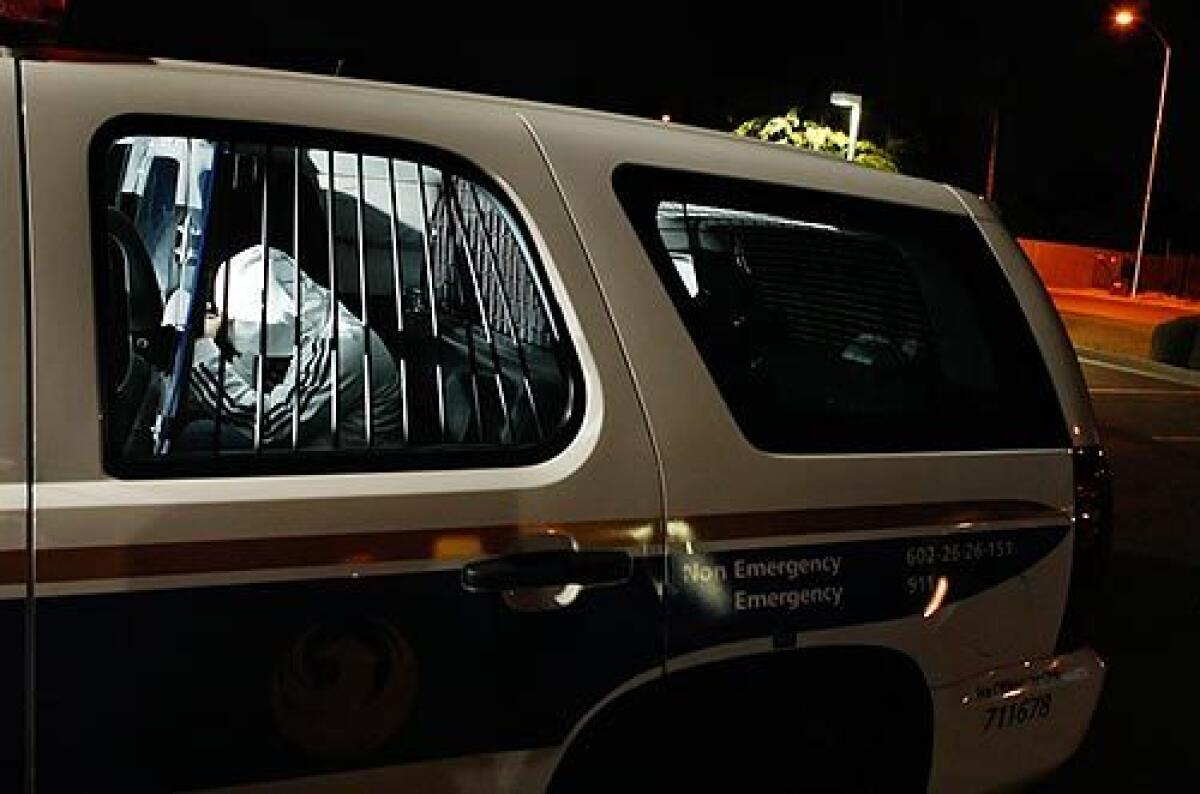Phoenix, kidnap-for-ransom capital

In broad daylight one January afternoon, on a street of ranch-style houses with kidney-shaped swimming pools, Juan Francisco Perez-Torres was kidnapped in front of his wife, daughter and three neighbors.
FOR THE RECORD:
Kidnapping capital: A photo caption in Thursday’s Section A with an article on ransom kidnappings in Phoenix gave the incorrect name of Jose Perez-Torres for victim Juan Francisco Perez-Torres. —
Two men with a gun grabbed the 34-year-old from his van and dragged him 50 yards to a waiting SUV. His wife threw rocks at the car, then gave chase in her own SUV. Neighbors in northwest Phoenix called police. Yet when police found her later, she at first denied there was a problem.
On the phone later, as detectives listened in, kidnappers said Perez-Torres had stolen someone’s marijuana.
But police were used to conflicting story lines by now. It was Phoenix, after all: More ransom kidnappings happen here than in any other town in America, according to local and federal law enforcement authorities. Most every victim and suspect is connected to the drug-smuggling world, usually tracing back to the western Mexican state of Sinaloa, Phoenix police report.
Arizona has become the new drug gateway into the United States. Roughly half of all marijuana seized along the U.S.-Mexico border was taken on the state’s 370-mile border with Mexico.
One result is an epidemic of kidnapping that many residents are barely aware of. Indeed, most every other crime here is down. But police received 366 kidnapping-for-ransom reports last year, and 359 in 2007. Police estimate twice that number go unreported.
In September, police spun off a separate detective unit to handle only these smuggling-related kidnappings and home-invasion robberies. Its detectives are now considered among the country’s most expert in those crimes.
That Thursday afternoon last month, Perez-Torres’ abduction fell to the unit’s two most seasoned detectives, Gina Garcia and Arnulfo “Sal” Salgado, as they were about to leave work. Over the next 42 hours, the kidnapping would consume their every waking moment.
“You never know which way it’s going to go,” Garcia said. “Sometimes you hear the victim screaming, pleading for help, pleading for their life. You have to stay calm. Talk is huge in this business.”
Talk got serious that night, about seven hours after Perez-Torres was abducted.
Over the phone, the kidnapper sounded drunk.
“Get moving,” he told Andres, a partner with Perez-Torres in a small-scale auto sales business, who pretended to be the victim’s brother. “Start selling things.”
He demanded $150,000.
Standing with Andres in the department’s “kidnap room” -- a small office with a window, television and tape recorder -- Garcia mouthed responses. “Tell him you want to talk to the victim,” she said. “Don’t agree to anything.”
Garcia was a child when she crossed the Mexico-Arizona border illegally with her parents and eight siblings. She grew up in a tough Phoenix barrio, obtained legal status and was steered to police work by a youth activities program. Five years ago, she joined the kidnapping unit, and has worked hundreds of cases since then.
Her job is to steady the nerves of victims’ relatives as they take calls from kidnappers, who often torture their victims while talking to the families. Sometimes she steps in and, in a bit of life-or-death theater, pretends to be the victim’s cousin or friend. That’s when her native norteño accent pays off.
Andres, who asked that his surname not be used for this article, didn’t need much calming. He pleaded well -- not too whiny, not too insistent.
“Put yourself in my place. I want to know how my brother is. I want to hear his voice,” he said. “Why don’t you put him on the phone for a bit?”
The kidnapper refused, said he’d call the next morning. The conversation ended.
In Phoenix, kidnappers apparently don’t call after midnight; usually, they’re sleeping or they’re high. So Garcia and the other detectives went home. It was late, and things were off to a typical start.
Ransom kidnapping is a rare crime in America. Most cops go their entire careers without handling one. These days, most kidnappings involve a husband taking a child from an estranged wife. That’s how things were in Phoenix until a few years ago.
Then things changed in Sinaloa.
Along the Pacific Coast several hours south of Arizona, Sinaloa is the state where drug smuggling in Mexico began. Most Mexican cartels originated there. Kidnapping was how they collected debts. For many years, they kidnapped other smugglers and left law-abiding citizens alone.
But after several major traffickers died or went to prison, younger gunmen stopped playing by the old rules. In the late 1990s and 2000, Sinaloa had its first rash of kidnappings of legitimate merchants and businessmen.
Phoenix first saw large numbers of ransom kidnappings reported during these years as well.
A fast-growing city, Phoenix had long been a destination for Mexican immigrants, and for Sinaloans in particular. Today, Phoenix detectives say, only the rare kidnapper is not from Sinaloa. They often come from the same Sinaloan towns: Los Mochis, Leyva, Guasave.
Like construction or restaurant work, kidnapping in Phoenix relies on cheap Mexican laborers. The grunt work, like guarding the victim, is often done by young, unemployed illegal immigrants, desperate for work, who sign on for $50 to $200 a day, Garcia said.
Certain Phoenix bars -- Señor Lucky’s, Bronco Bar and El Gran Mercado -- are known as places where kidnappers recruit, much the way builders go to Home Depot to hire day laborers, police say.
The day Perez-Torres was kidnapped, police raided a south Phoenix tire shop and found shotguns, ammunition and ballistic vests.
The business belonged to a man they suspected of setting up a kidnapping and home-invasion empire. He recruited illegal immigrants, provided them with criminal work and a place to live at the shop, then would order them around like a small-town baron, police said. Occasionally he’d hit them and interrogate them.
Kidnapping in Phoenix attracts immigrants whose American dream is to make it big in the underworld. In Mexico, cartels limit their options. But cartel control is weak in Phoenix. Many resort to kidnapping because “for once, they’re the guys with the gun, the ones with the power,” Salgado said. “They are in control. In Mexico they’re not in control.”
It was 7 p.m. Friday. After several phone calls, the kidnappers ordered money to be taken to an intersection in west Phoenix.
Perez-Torres’ family had come in that afternoon with $12,000, which they said was from selling cars.
So detectives lied.
“We told the suspect we do have the 150K,” said Sgt. Phil Roberts, a unit supervisor. “We’re going to tell him whatever he wants.”
The case now passed to Salgado, who went undercover, accompanying Andres -- still posing as Perez-Torres’ brother -- into west Phoenix.
Nine years ago, Salgado was the first Phoenix detective to investigate the smuggler kidnappings. He comforted the victim’s family, negotiated, oversaw rescues. He learned to listen for compassion or cold-bloodedness.
For about a year, Salgado worked alone. The caseload grew incessantly. Today, probably no detective in America has worked more ransom kidnapping cases.
During an investigation, Salgado barely sleeps. When it’s over, he crashes hard. Twice, dentists prescribed mouth guards to keep him from grinding his teeth. He chewed through each in a week.
To hear Salgado describe it, each kidnapping is like a jazz improvisation, with every move creating two or three new possibilities, which detectives must anticipate, depending on the suspect’s tone of voice and what’s come before.
“None are alike, and they’re all the same,” Salgado said. “You don’t know what to expect, but you know what to expect.”
With that in mind, Salgado set out that night in a pickup truck with Andres.
Few west Phoenix residents perceived the ballet of two unwitting suspects and dozens of officers that silently swept back and forth through their neighborhood.
Kidnappers called to tell Salgado and Andres to drive around with their windows down. They ordered them to stop at a gas station, then to get out and raise their shirts. Other officers watched from the shadows, giving them a wide berth.
For more than an hour kidnappers ordered Salgado and Andres through maneuvers, looking for signs of cops, apparently unaware of the undercover officers silently cruising the area looking for the kidnappers.
Then things happened fast. Officers were following a suspicious bronze Chevy truck, when the driver bolted down a residential street and into a driveway. Two men jumped out and ran. One dropped a gun.
Officers grabbed them after a short chase and before they could call their accomplices. If anything happened to Perez-Torres, officers said, they’d be charged with murder. The two men caved. He was being held, they said, in a house in Mesa, half an hour away.
A caravan of cops now sped for Mesa. They got there as three men were pushing Perez-Torres into a brown truck; a black Chrysler idled nearby. Both sped off but didn’t get far. Police arrested three more men.
By 9:30, Juan Perez-Torres was safe, and five of his alleged kidnappers were about to be questioned.
They told detectives a bleak border tale.
Max Portillo, 24, said he’d been having trouble with a drug smuggler in Nogales, Mexico, known as “El Chueco” -- Twisted. El Chueco said Perez-Torres owed him for a load of marijuana, and he wanted someone to kidnap him.
Portillo said he recruited the others at bars. Another suspect, Abel Mosqueda, said he met Portillo at El Gran Mercado. Mosqueda told detectives he was out of work and needed money. Among the five of them, they had one gun: a black .45. They said they’d never kidnapped before.
How much of it was true? “That voice,” Gina Garcia said, “I’m sure he’s done this before from the way he conducted the negotiation.”
But detectives hadn’t time for the case’s murky motives. They had the kidnappers’ confessions and other evidence. Prosecutors had been getting plea-bargains of 12 years in prison for less. In a few months, they’d have trouble remembering the case.
Detectives now check victims for warrants and have dogs sniff ransom money for drugs, under the theory that today’s victims are tomorrow’s suspects. They’ve seized property valued at close to $1 million.
Phoenix police say they have never lost a victim during a rescue attempt. But detectives wondered how long their record would hold, and how long they could stave off the violence that has left more than 8,000 people dead in Mexico in the last two years.
“The way I understand it, the vice president of the Bank of Mexico has to go to work with armed escorts,” Sgt. Roberts said. “The vice president of Wells Fargo in Phoenix does not. We’re trying to prevent that from happening. If the United States as a whole doesn’t do something about this, it’s possible it could go that way.”
About 4 a.m. Saturday, the family of Juan Francisco Perez-Torres huddled in the police lobby, waiting to drive him home. He denied smuggling drugs. Fixing and selling used cars was how he made his money, he said. No detective believed him.
Six hours later, Garcia finally went home. She hadn’t slept in more than a day. Nonetheless, she had passed up a chance to move up to sergeant.
“It’s good to save people, and it’s good to put people away,” she said.
The job was in Salgado’s blood as well, and he couldn’t quit it.
“The thing about kidnapping is,” he said, “it’s the only crime that’s occurring as it’s being investigated.”
This one was now done.
More to Read
Start your day right
Sign up for Essential California for news, features and recommendations from the L.A. Times and beyond in your inbox six days a week.
You may occasionally receive promotional content from the Los Angeles Times.






